leetcode二叉树题目总结
leetcode二叉树题目总结
题目链接:https://leetcode-cn.com/leetbook/detail/data-structure-binary-tree/
前序遍历(NLR)
- public List<Integer> preorderTraversal(TreeNode root) {
- List<Integer> res = new ArrayList<>();
- preOrder(root, res);
- return res;
- }
-
- public void preOrder(TreeNode root, List<Integer> res) {
- if (root == null)
- return;
- res.add(root.val);
- preOrder(root.left, res);
- preOrder(root.right, res);
- }
- public List<Integer> preorderTraversal(TreeNode root) {
中序遍历(LNR)
- inOrder(root.left, res);
- res.add(root.val);
- inOrder(root.right, res);
- inOrder(root.left, res);
后序遍历( LRN )
- postOrder(root.left, res);
postOrder(root.right, res);
res.add(root.val);
- postOrder(root.left, res);
层次遍历
- 3
/ \
9 20
/ \
15 7
结果
[
[3],
[9,20],
[15,7]
]
关键代码
- public List<List<Integer>> levelOrder(TreeNode root) {
- // 空树判断
- if(root == null) return result;
- // 返回的结果
- List<List<Integer>> result = new ArrayList<>();
- // 队列
- Queue<TreeNode> queue = new LinkedList<>();
- // 根节点入队
- queue.add(root);
- // 队列不为空则循环
- while(queue.size()>0){
- // 内层节点序列
- List<Integer> temp = new ArrayList<>();
- // 遍历队列,把当前层的元素从队列取出来,将下一层放入队列
- for(int i=0;i<size;i++){
- // 当前节点放入结果数组
- TreeNode cur = queue.poll();
- temp.add(cur);
- // 左节点入队
- if(cur.left){
- queue.add(cur.left);
- }
- // 右节点入队
- if(cur.right){
- queue.add(cur.right)
- }
- }
- result.add(temp);
- }
- return result;
- }
二叉树最大深度
递归解决:
递归出口 当前节点 == null 返回0
递归逻辑 Math.max(maxDept(root.left) +1, maxDepth(root.right) +1)
- public int maxDepth(TreeNode root) {
- if(root == null) return 0;
- return Math.max(maxDepth(root.left)+1, maxDepth(root.right)+1);
- }
对称二叉树
递归法:
递归出口: 两个节点同时为空 return true 有一个为空 return false
递归逻辑: 返回当前节点值是否相等 && 递归节点1的左节点和节点2的右节点 && 递归节点2的右节点和节点1的左节点
- class Solution {
- public boolean isSymmetric(TreeNode root) {
- return isMirror(root, root);
- }
- public boolean isMirror(TreeNode t1, TreeNode t2) {
- if (t1 == null && t2 == null) return true;
- if (t1 == null || t2 == null) return false;
- return (t1.val == t2.val)
- && isMirror(t1.left, t2.right)
- && isMirror(t1.right, t2.left);
- }
- }
路径总和
递归法: 递归出口: 当前节点==null判断 当前的 target是否为0,是则返回true,否返回false
递归逻辑: DFS所有节点,每次遍历到当前节点将target-cur.val
- class Solution {
- public boolean hasPathSum(TreeNode root, int targetSum){
- // 处理root为空的情况
- if(root == null){
- return false;
- }
- // 叶子节点判定当前路径是否可行
- if(root.left==null && root.right==null){
- return root.val == targetSum;
- }
- return hasPathSum(root.left,targetSum-root.val) || hasPathSum(root.right,targetSum-root.val);
- }
- }
中序后序构造二叉树
思路:
通过后序遍历确定每一个根节点
通过DFS递归,限定范围得到左右子树
递归出口 后序遍历的head > tail
通过找到当前节点在中序遍历中的位置限定范围
- class Solution {
- public TreeNode buildTree(int[] inorder, int[] postorder) {
- int len=inorder.length;
- if(len==0)return null;
- return dfs(inorder,postorder,0,len-1,0,len-1);
- }
-
- TreeNode dfs(int[] inorder, int[] postorder,int head1,int tail1, int head2,int tail2){
- // 由于postOrder每次都会在tail-1 所以当只有一个元素则会返回
- if(head2>tail2)return null;
- int val=postorder[tail2];
- TreeNode root=new TreeNode(val);
- if(head2==tail2)return root;
-
- int mid=0; //拆分点mid的位置是相对的,因为h1!=h2
- while(inorder[head1+mid]!=val)mid++;
-
- root.left=dfs(inorder, postorder, head1, head1+mid-1, head2, head2+mid-1);
- root.right=dfs(inorder, postorder, head1+mid+1, tail1, head2+mid, tail2-1);
-
- return root;
- }
- }
笔记:
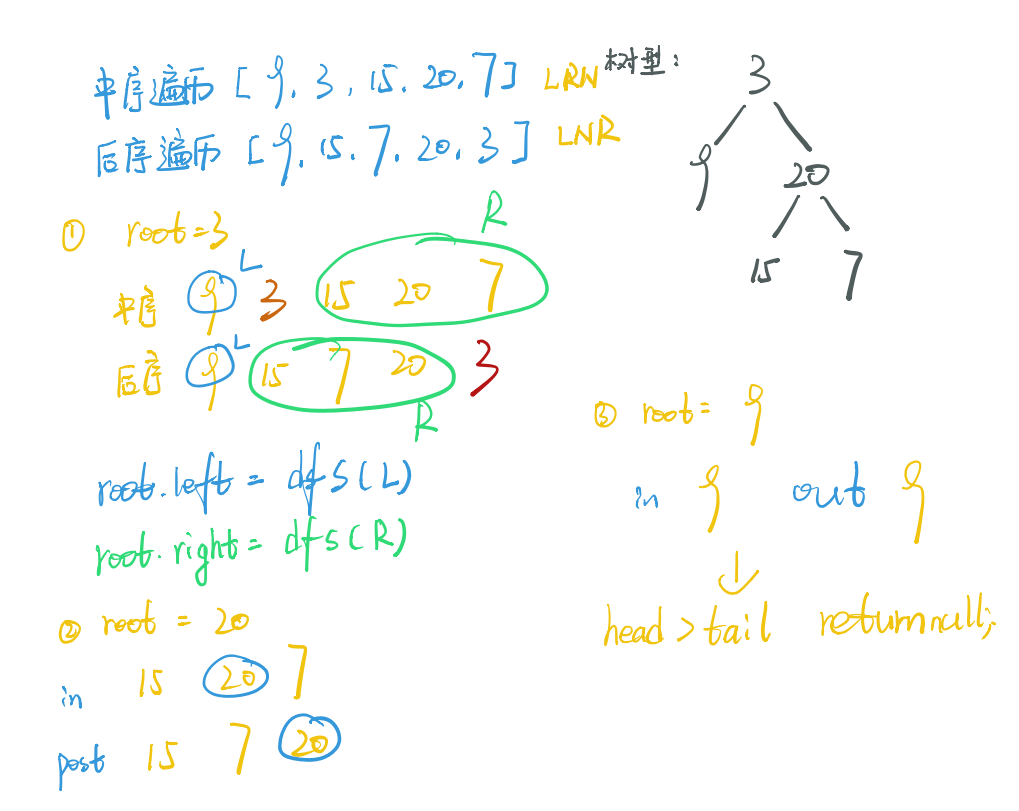
前序中序构造二叉树类似
和中序前序类似, 只是每次的限定范围不同
二叉树填充右侧指针
递归法: 限定完美二叉树
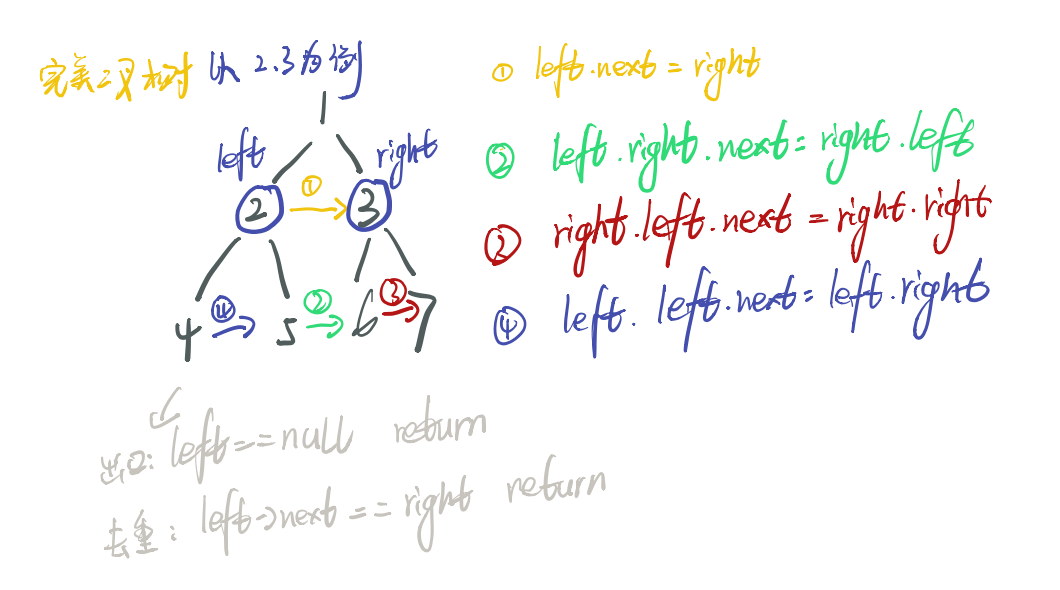
- class Solution {
public Node connect(Node root){
if(root!=null) dfs(root.left, root.right);
return root;
}
void dfs(Node left, Node right){
if(left ==null || left.next == right) return;
left-> next = right;
dfs(left.left, left.right);
dfs(left.right, right.left);
dfs(right.left, right.right);
}
}
一般情况
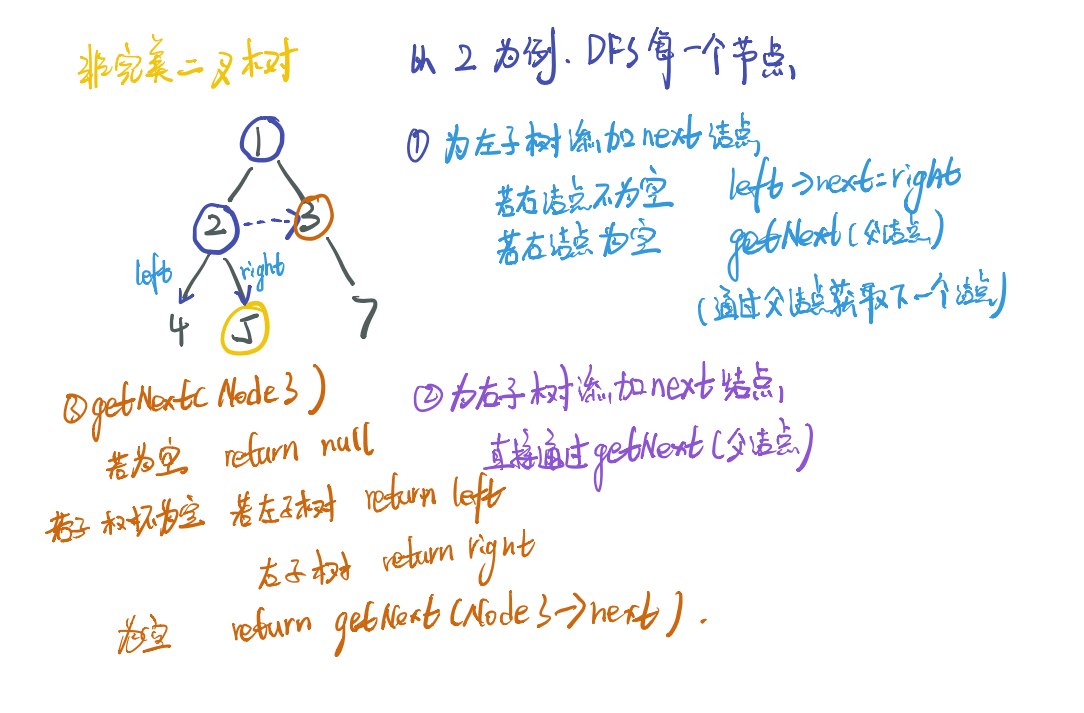
- /*
- // Definition for a Node.
- class Node {
- public:
- int val;
- Node* left;
- Node* right;
- Node* next;
-
- Node() : val(0), left(NULL), right(NULL), next(NULL) {}
-
- Node(int _val) : val(_val), left(NULL), right(NULL), next(NULL) {}
-
- Node(int _val, Node* _left, Node* _right, Node* _next)
- : val(_val), left(_left), right(_right), next(_next) {}
- };
- */
-
- class Solution {
- public:
- Node* connect(Node* root) {
- // 空树判断
- if( root == nullptr ) return nullptr;
- // 左树为空
- if( root -> left != nullptr ) {
- if( root -> right != nullptr){
- // 最普遍的情况
- root -> left -> next = root -> right;
- }
- else
- // 父节点的next的第一个子节点作为next
- root -> left -> next = getNext(root -> next);
- }
- // 右节点不为空
- if( root->right != nullptr){
- // next
- root -> right -> next = getNext( root-> next );
- }
- // 先判断右节点
- connect(root->right);
- connect(root->left);
-
- return root;
- }
- // 通过父节点获取子节点的next结点
- Node* getNext(Node* uncle){
- if( uncle == nullptr ) return nullptr;
- if( uncle -> left != nullptr) return uncle->left;
- if( uncle -> right != nullptr ) return uncle->right;
- return getNext(uncle->next);
- }
- };
最近公共祖先
整体思路:1. 通过BFS得到每个节点和其父节点的Map
通过Set,保存p到根节点的路径
在通过获得q到根节点的路径,判断第一个包含在原来的set的节点为最先公共祖先
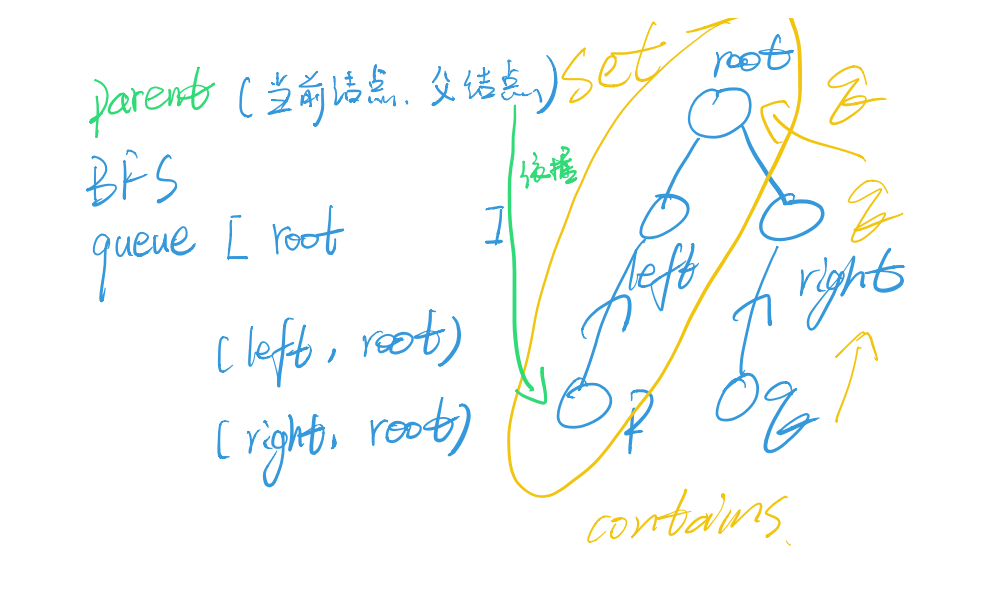
代码:
- public TreeNode lowestCommonAncestor(TreeNode root, TreeNode p, TreeNode q) {
- //记录遍历到的每个节点的父节点。
- Map<TreeNode, TreeNode> parent = new HashMap<>();
- Queue<TreeNode> queue = new LinkedList<>();
- //根节点没有父节点,所以为空
- parent.put(root, null);
- //队列入队
- queue.add(root);
- //直到两个节点都找到为止。
- while (!parent.containsKey(p) || !parent.containsKey(q)) {
- //队列是一边进一边出,这里poll方法是出队,
- TreeNode node = queue.poll();
- if (node.left != null) {
- //左子节点不为空,记录下他的父节点
- parent.put(node.left, node);
- //左子节点不为空,把它加入到队列中
- queue.add(node.left);
- }
- //右节点同上
- if (node.right != null) {
- parent.put(node.right, node);
- queue.add(node.right);
- }
- }
- Set<TreeNode> ancestors = new HashSet<>();
- //记录下p和他的祖先节点,从p节点开始一直到根节点。
- while (p != null) {
- ancestors.add(p);
- p = parent.get(p);
- }
- //查看p和他的祖先节点是否包含q节点,如果不包含再看是否包含q的父节点……
- while (!ancestors.contains(q))
- q = parent.get(q);
- return q;
- }
-
二叉树的序列化和反序列化
分析思路:
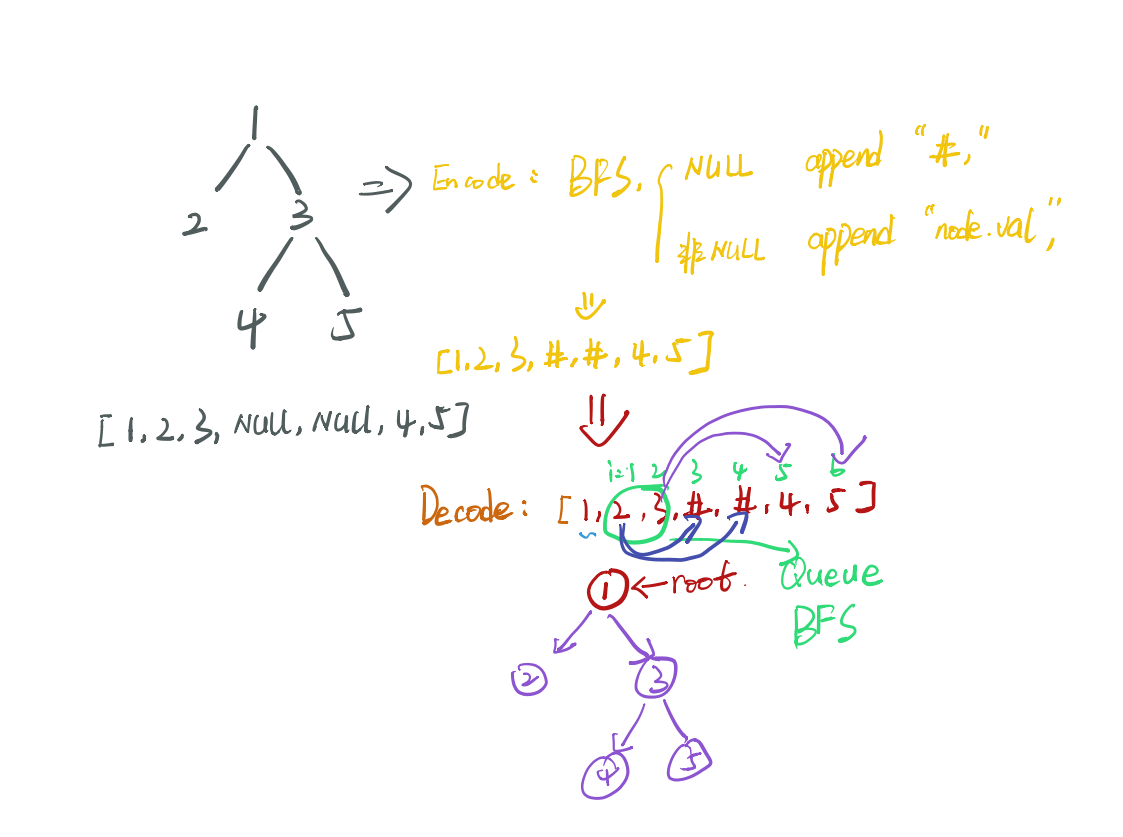
代码:
- /**
- * Definition for a binary tree node.
- * public class TreeNode {
- * int val;
- * TreeNode left;
- * TreeNode right;
- * TreeNode(int x) { val = x; }
- * }
- */
- public class Codec {
-
- // Encodes a tree to a single string.
- public String serialize(TreeNode root) {
- if(root == null) return "#";
- Queue<TreeNode> queue = new LinkedList<TreeNode>();
- StringBuffer res = new StringBuffer();
- queue.add(root);
- while(!queue.isEmpty()){
- TreeNode node = queue.poll();
- if(node == null){
- res.append("#,");
- continue;
- }
- res.append(node.val + ",");
- queue.add(node.left);
- queue.add(node.right);
- }
- return res.toString();
- }
-
- // Decodes your encoded data to tree.
- public TreeNode deserialize(String data) {
- if(data == "#") return null;
- Queue<TreeNode> queue = new LinkedList<>();
- String[] values = data.split(",");
- // 第一个节点
- TreeNode node = new TreeNode(Integer.parseInt(values[0]));
- queue.add(node);
- for(int i =1; i < values.length; i++){
- TreeNode treeNode = queue.poll();
- if(!"#".equals(values[i])){
- treeNode.left = new TreeNode(Integer.parseInt(values[i]));
- queue.add(treeNode.left);
- }
- if(!"#".equals(values[++i])){
- treeNode.right = new TreeNode(Integer.parseInt(values[i]));
- queue.add(treeNode.right);
- }
- }
- return node;
- }
- }
-
- // Your Codec object will be instantiated and called as such:
- // Codec ser = new Codec();
- // Codec deser = new Codec();
- // TreeNode ans = deser.deserialize(ser.serialize(root));
leetcode二叉树题目总结的更多相关文章
- 面试大总结之二:Java搞定面试中的二叉树题目
package BinaryTreeSummary; import java.util.ArrayList; import java.util.Iterator; import java.util.L ...
- leetcode上题目的分类
leetcode链表部分题目 https://zhuanlan.zhihu.com/p/29800285 <[Leetcode][链表]相关题目汇总/分析/总结> leetcode堆部分题 ...
- 二叉树题目集合 python
二叉树是被考察频率非常高的数据结构.二叉树是按照“父节点-左子树&右子树”这样的方式,由根节点不断向下扩展,形成一棵树的结构.二叉树经常被提到的三种遍历方式:前序遍历.中序遍历和后序遍历,既是 ...
- LeetCode二叉树实现
LeetCode二叉树实现 # 定义二叉树 class TreeNode: def __init__(self, x): self.val = x self.left = None self.righ ...
- LeetCode高频题目(100)汇总-Java实现
LeetCode高频题目(100)汇总-Java实现 LeetCode高频题目(100)汇总-Java实现 目录 第01-50题 [Leetcode-easy-1] Two Sum [Le ...
- LeetCode算法题目解答汇总(转自四火的唠叨)
LeetCode算法题目解答汇总 本文转自<四火的唠叨> 只要不是特别忙或者特别不方便,最近一直保持着每天做几道算法题的规律,到后来随着难度的增加,每天做的题目越来越少.我的初衷就是练习, ...
- LeetCode SQL题目(第一弹)
LeetCode SQL题目 注意:Leetcode上的SQL编程题都提供了数据表的架构程序,只需要将它贴入本地数据库即可调试自己编写的程序 不管是MS-SQL Server还是MySQL都需要登陆才 ...
- LeetCode 二叉树,两个子节点的最近的公共父节点
LeetCode 二叉树,两个子节点的最近的公共父节点 二叉树 Lowest Common Ancestor of a Binary Tree 二叉树的最近公共父亲节点 https://leetcod ...
- 已知前序(后序)遍历序列和中序遍历序列构建二叉树(Leetcode相关题目)
1.文字描述: 已知一颗二叉树的前序(后序)遍历序列和中序遍历序列,如何构建这棵二叉树? 以前序为例子: 前序遍历序列:ABCDEF 中序遍历序列:CBDAEF 前序遍历先访问根节点,因此前序遍历序列 ...
随机推荐
- Mysql、Oracle锁表处理
MySql解锁方式 1 # 1. 查看当前数据库锁表的情况 2 SELECT * FROM information_schema.INNODB_TRX; 3 # 2. 杀掉查询结果中锁表的trx_my ...
- Firefox 国外换为国内同步的服务器地址
地址栏键入 about:config点击 接受风险并同意查找 identity把右侧字符串包含 firefox.com 替换为 firefox.com.cn 即换为国内同步服务器反之把 firefox ...
- 在 K8s 上运行 GraphScope
本文将详细介绍:1) 如何基于 Kubernetes 集群部署 GraphScope ; 2) 背后的工作细节; 3) 如何在分布式环境中使用自己构建的 GraphScope 开发镜像. 上篇文章介绍 ...
- 01. 树莓派初始配置——ssh连接使用root用户登录
ssh连接使用root用户登录 普通的"pi"用户没有权限访问某些文件夹,或者对它们只有只读功能.部分操作需要在每条命令前都要加上"sudo",非常不方便.切换 ...
- Python 查找算法_众里寻他千百度,蓦然回首那人却在灯火阑珊处(线性、二分,分块、插值查找算法)
查找算法是用来检索序列数据(群体)中是否存在给定的数据(关键字),常用查找算法有: 线性查找: 线性查找也称为顺序查找,用于在无序数列中查找. 二分查找: 二分查找也称为折半查找,其算法用于有序数列. ...
- ASP.NET Web 应用 Docker踩坑历程
听说Docker这玩意挺长时间了,新建Web应用的时候,也注意到有个启用Docker的选项. 前两天扫了一眼<[大话云原生]煮饺子与docker.kubernetes之间的关系>,觉得有点 ...
- XCTF练习题---MISC---Erik-Baleog-and-Olaf
XCTF练习题---MISC---Erik-Baleog-and-Olaf flag:flag{#justdiffit} 解题步骤: 1.观察题目,下载附件 2.拿到手以后发现是一个没有后缀名的文件, ...
- CoreWCF 1.0.0 发布,微软正式支持WCF
2022年4月28日,我们达到了一个重要的里程碑,并发布了CoreWCF的1.0.0版本.对Matt Connew (微软WCF团队成员)来说,这是5年前即 2017年1月开始的漫长旅程的结束.Mat ...
- java基础4.18
1.java的"一次编写,处处运行"如何实现?: 答:java之所有能实现一次编译,到处运行,是因为java在每个系统平台上都有java虚拟机(jvm),java编译的中间文件cl ...
- 入行IT,一定要会Linux吗?
现在是21世纪,是科学技术大力发展的一个时代,IT行业已经成为现在的一个非常热门的一个行业,许许多多的人都想要往IT方面发展,找IT方面相关的一个工作.很多想要接触IT行业的初学者伤透了脑筋,我该学什 ...
